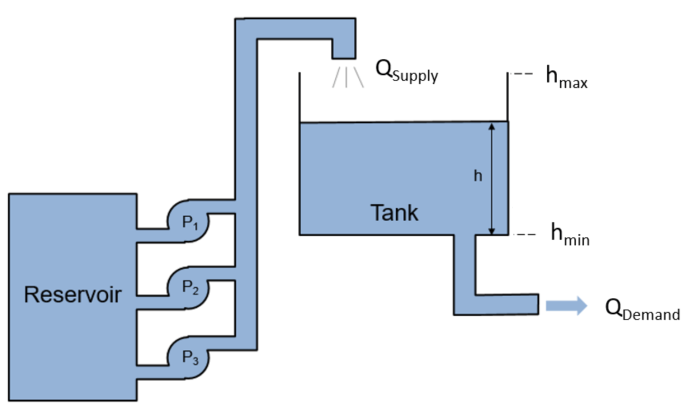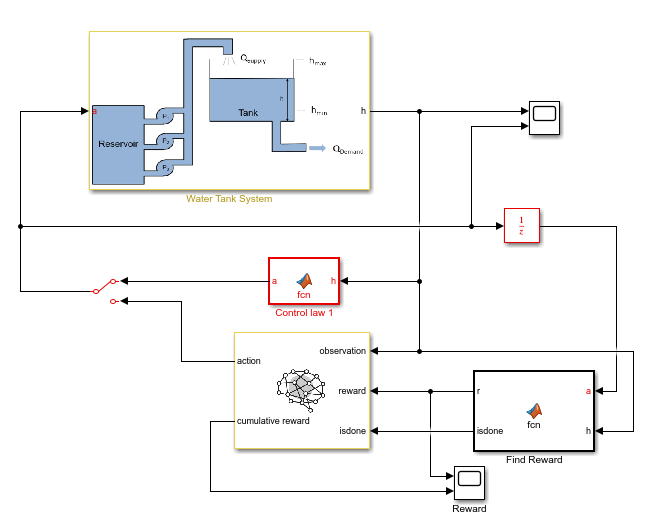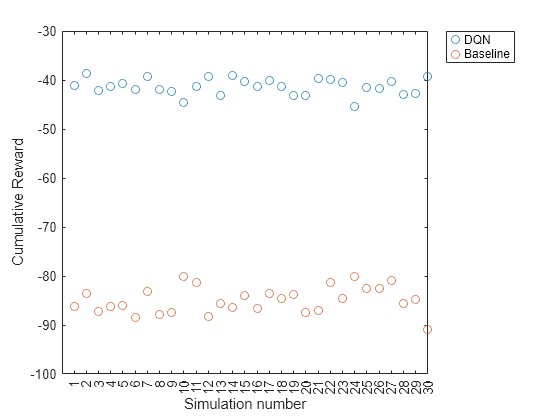Water Distribution System Scheduling Using Reinforcement Learning
This example shows how to learn an optimal pump scheduling policy for a water distribution system using reinforcement learning (RL).
Fix Random Number Stream for Reproducibility
The example code might involve computation of random numbers at various stages. Fixing the random number stream at the beginning of various sections in the example code preserves the random number sequence in the section every time you run it, and increases the likelihood of reproducing the results. For more information, see Results Reproducibility.
Fix the random number stream with seed 0 and random number algorithm Mersenne Twister. For more information on controlling the seed used for random number generation, see rng.
previousRngState = rng(0,"twister");The output previousRngState is a structure that contains information about the previous state of the stream. You will restore the state at the end of the example.
Water Distribution System
The following figure shows a water distribution system.

Here:
is the amount of water supplied to the water tank from a reservoir.
is the amount of water flowing out of the tank to satisfy usage demand.
The objective of the reinforcement learning agent is to schedule the number of pumps running to both minimize the energy usage of the system and satisfy the usage demand (). The dynamics of the tank system are governed by the following equation.
Here, and . The demand over a 24 hour period is a function of time given as
where is the expected demand and represents the demand uncertainty, which is sampled from a uniform random distribution.
The supply is determined by the number of pumps running, according to the following mapping.
To simplify the problem, power consumption is defined as the number of pumps running, .
The following function is the reward for this environment. To avoid overflowing or emptying the tank, an additional cost is added if the water height is close to the maximum or minimum water levels, or , respectively.
Generate Demand Profile
To generate and a water demand profile based on the number of days considered, use generateWaterDemand defined at the end of this example.
num_days = 4; % Number of days
[WaterDemand,T_max] = generateWaterDemand(num_days);View the demand profile.
plot(WaterDemand)

Open and Configure Model
Open the distribution system Simulink® model.
mdl = "watertankscheduling";
open_system(mdl)
In addition to the reinforcement learning agent, a simple baseline controller is defined in the Control law MATLAB Function block. This controller activates a certain number of pumps depending on the water level.
Specify the initial water height.
h0 = 3; % mSpecify the model parameters.
SampleTime = 0.2; H_max = 7; % Max tank height (m) A_tank = 40; % Area of tank (m^2)
Create Environment Object
To create an environment object for the Simulink model, first define the action and observation specifications, actInfo and obsInfo, respectively. The agent action is the selected number of pumps. The agent observation is the water height, which is measured as a continuous-time signal.
actInfo = rlFiniteSetSpec([0,1,2,3]); obsInfo = rlNumericSpec([1,1]);
Create the environment object.
env = rlSimulinkEnv(mdl,mdl+"/RL Agent",obsInfo,actInfo);Initialize the random seed for each simulation.
simulationSeed(0);
Specify the custom reset function localResetFcn, which is defined at the end of this example, that randomizes the initial water height and the water demand. Doing so allows the agent to be trained on different initial water levels and water demand functions for each episode.
env.ResetFcn = @localResetFcn;
Create DQN Agent
DQN agents use a parameterized Q-value function approximator to estimate the value of the policy. Since DQN agents have a discrete action space, you have the option to create a vector (that is multi-output) Q-value function critic, which is generally more efficient than a comparable single-output critic.
A vector Q-value function takes only the observation as input and returns as output a single vector with as many elements as the number of possible actions. The value of each output element represents the expected discounted cumulative long-term reward when an agent starts from the state corresponding to the given observation and executes the action corresponding to the element number (and follows a given policy afterwards).
The network parameters are initialized randomly. Ensure reproducibility of the section by fixing the seed of the random generator.
rng(0,"twister");To model the parameterized Q-value function within the critic, use a non-recurrent neural network.
layers = [
featureInputLayer(obsInfo.Dimension(1))
fullyConnectedLayer(32)
reluLayer
fullyConnectedLayer(32)
reluLayer
fullyConnectedLayer(32)
reluLayer
fullyConnectedLayer(numel(actInfo.Elements))
];Create to a dlnetwork object and display the number of parameters.
dnn = dlnetwork(layers); summary(dnn)
Initialized: true
Number of learnables: 2.3k
Inputs:
1 'input' 1 features
Create a critic using rlVectorQValueFunction using the defined deep neural network and the environment specifications.
critic = rlVectorQValueFunction(dnn,obsInfo,actInfo);
Create DQN Agent with Custom Network
Specify training options for the critic and the actor using rlOptimizerOptions.
criticOpts = rlOptimizerOptions(LearnRate=1e-2,GradientThreshold=10);
Specify the agent options using rlDQNAgentOptions. If you are using an LSTM network, set the sequence length to 20.
opt = rlDQNAgentOptions(SampleTime=SampleTime); opt.DiscountFactor = 0.995; opt.ExperienceBufferLength = 1e6; opt.EpsilonGreedyExploration.EpsilonDecay = 1e-5; opt.EpsilonGreedyExploration.EpsilonMin = .02; opt.MiniBatchSize = 128; opt.TargetSmoothFactor = 1e-2;
Include the training options for the critic.
opt.CriticOptimizerOptions = criticOpts;
Create the agent using the critic and the options object.
agent = rlDQNAgent(critic,opt);
Train Agent
To train the agent, first specify the training options. For this example, use the following options.
Run training for
500episodes, with each episode lasting atceil(T_max/Ts)time steps.Display the training progress in the Reinforcement Learning Training Monitor dialog box (set the
Plotsoption).Specify the averaging window length of
100for the episode rewards.
Specify the options for training using an rlTrainingOptions object.
trainOpts = rlTrainingOptions(... MaxEpisodes=500, ... MaxStepsPerEpisode=ceil(T_max/SampleTime), ... Verbose=false, ... Plots="training-progress",... StopTrainingCriteria="none",... ScoreAveragingWindowLength=100);
Fix the random stream for reproducibility.
rng(0,"twister");Train the agent using the train function. Training this agent is a computationally intensive process that takes several hours to complete. To save time while running this example, load a pretrained agent by setting doTraining to false. To train the agent yourself, set doTraining to true.
doTraining =false; if doTraining % Connect the RL Agent block by toggling % the Manual Switch block set_param(mdl+"/Manual Switch","sw","0"); % Train the agent. trainingStats = train(agent,env,trainOpts); else % Load the pretrained agent for the example. load("SimulinkWaterDistributionDQN.mat","agent") end
The following figure shows the training progress.

Simulate DQN Agent
To validate the performance of the trained agent, simulate it in the water-tank environment. For more information on agent simulation, see rlSimulationOptions and sim.
To simulate the agent performance, connect the RL Agent block by toggling the manual switch block.
set_param(mdl+"/Manual Switch","sw","0");
Set the maximum number of steps for each simulation and the number of simulations. For this example, run 30 simulations. The environment reset function sets a different initial water height and water demand are different in each simulation.
NumSimulations = 30; simOptions = rlSimulationOptions( ... MaxSteps=T_max/SampleTime,... NumSimulations=NumSimulations);
To compare the agent with the baseline controller under the same conditions, reset the initial random seed used in the environment reset function.
simulationSeed(0);
Simulate the agent against the environment.
experienceDQN = sim(env,agent,simOptions);
Simulate Baseline Controller
To compare DQN agent with the baseline controller, you must simulate the baseline controller using the same simulation options and initial random seed for the reset function.
Enable the baseline controller.
set_param(mdl+"/Manual Switch","sw","1");
To compare the agent with the baseline controller under the same conditions, reset the random seed used in the environment reset function.
simulationSeed(0);
Simulate the baseline controller against the environment.
experienceBaseline = sim(env,agent,simOptions);
Compare DQN Agent with Baseline Controller
Initialize cumulative reward result vectors for both the agent and baseline controller.
resultVectorDQN = zeros(NumSimulations, 1); resultVectorBaseline = zeros(NumSimulations,1);
Calculate cumulative rewards for both the agent and the baseline controller.
for ct = 1:NumSimulations resultVectorDQN(ct) = sum(experienceDQN(ct).Reward); resultVectorBaseline(ct) = sum(experienceBaseline(ct).Reward); end
Plot the cumulative rewards.
plot([resultVectorDQN resultVectorBaseline],"o") set(gca,"xtick",1:NumSimulations) xlabel("Simulation number") ylabel("Cumulative Reward") legend("DQN","Baseline","Location","NorthEastOutside")

The cumulative reward obtained by the agent is consistently around –40. This value is much greater than the average reward obtained by the baseline controller. Therefore, the DQN agent consistently outperforms the baseline controller in terms of energy savings.
Restore the random number stream using the information stored in previousRngState.
rng(previousRngState);
Local Functions
Water Demand Function
function [WaterDemand,T_max] = generateWaterDemand(num_days) t = 0:(num_days*24)-1; % hr T_max = t(end); Demand_mean = [28, 28, 28, 45, 55, 110, ... 280, 450, 310, 170, 160, 145, ... 130, 150, 165, 155, 170, 265, ... 360, 240, 120, 83, 45, 28 ]'; % m^3/hr Demand = repmat(Demand_mean,1,num_days); Demand = Demand(:); % Add noise to demand a = -25; % m^3/hr b = 25; % m^3/hr Demand_noise = a + (b-a).*rand(numel(Demand),1); WaterDemand = timeseries(Demand + Demand_noise,t); WaterDemand.Name = "Water Demand"; WaterDemand.TimeInfo.Units = "hours"; end
Reset Function
function in = localResetFcn(in) % Use a persistent random seed value to evaluate the agent % and the baseline controller under the same conditions. randomSeed = simulationSeed(simulationSeed() + 1); rng(randomSeed); % Randomize water demand. num_days = 4; H_max = 7; [WaterDemand,~] = generateWaterDemand(num_days); assignin("base","WaterDemand",WaterDemand) % Randomize initial height. h0 = 3*randn; while h0 <= 0 || h0 >= H_max h0 = 3*randn; end blk = "watertankscheduling/Water Tank System/Initial Water Height"; in = setBlockParameter(in,blk,"Value",num2str(h0)); end function s = simulationSeed(u) persistent x; if isempty(x) x = 0; end if nargin x = u; end s = x; end
See Also
Functions
train|sim|rlSimulinkEnv